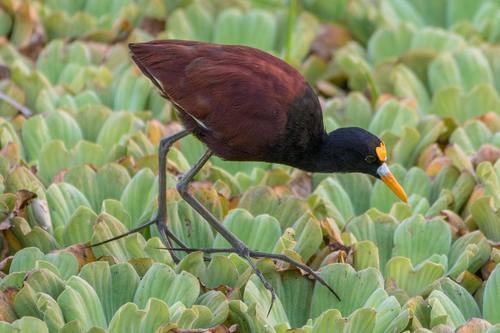
Northern Jacana
The Northern Jacana (*Jacana spinosa*) is a striking wading bird renowned for its extraordinarily long toes and claws, which enable it to walk across floating vegetation. This unique adaptation gives rise to the common names 'lily-trotter' or 'Jesus bird.' Found in wetlands from Mexico to Panama, and occasionally in the southern United States, the Northern Jacana plays a crucial role in its ecosystem by controlling insect populations and serving as an indicator species for wetland health. It also exhibits a fascinating polyandrous mating system, where females mate with multiple males, who are then responsible for parental care.
22-25 cm
Length
48-53 cm
Wingspan
Least Concern
Conservation Status
Distribution
The Northern Jacana's range extends from coastal Mexico, through Central America, to western Panama. It is also found in Cuba, Jamaica, and Hispaniola. Vagrants occasionally reach the southern United States, particularly Texas. They are not known for long-distance migrations, but may move locally in response to water level changes.
Lifespan
Lifespan data is limited, but estimates suggest 5-10 years in the wild.
Northern Jacana's Habitat
Habitat Types
Freshwater marshes, Shallow lakes, Ponds with abundant floating vegetation, Mangrove swamps (occasionally)
Climate Zones
Tropical, Subtropical
Adaptations
The Northern Jacana's most notable adaptation is its extremely elongated toes and claws. These distribute the bird's weight over a large surface area, allowing it to walk on floating aquatic plants like water lilies and water hyacinth without sinking.
Variations
There are three recognized subspecies: *J. s. spinosa*, *J. s. gymnostoma*, and *J. s. violacea*. These differ slightly in plumage coloration and the size of the frontal shield (wattle).
Appearance
Breeding Plumage
Adult plumage is generally consistent year-round.
Seasonal Feather Changes
No significant seasonal changes.
Sex Based Plumage Differences
Adults have chestnut-colored backs and wings, with a black head, neck, and breast. The flight feathers are yellowish-green. Juveniles have duller brown upperparts and white underparts. Females are larger and have a more prominent frontal shield.
Notable Features
Extremely long toes and claws, Sharp carpal spur on the wing (used for defense), Bright yellow frontal shield (wattle), Yellowish-green flight feathers
Diet and Feeding
Primary Foods
Insects, Other invertebrates (spiders, snails), Small fish, Seeds (occasionally)
Foraging Behavior
Northern Jacanas primarily glean insects and other invertebrates from the surface of floating vegetation or the water's surface. They walk slowly across the plants, using their long toes for support, and peck at prey. They may also probe in the mud or shallow water.
Specializations
Their long toes and claws are the primary specialization, allowing them to exploit a niche unavailable to most other wading birds.
Seasonal Diet Variations
Diet may vary slightly depending on the availability of prey, with a greater reliance on seeds during periods of insect scarcity.
Behavior
Social Structure
Northern Jacanas are generally solitary or found in pairs, except during the breeding season when females may gather multiple males. Females are territorial, defending their areas from other females.
Communication
Loud, raucous calls, Chattering calls during social interactions, Wing-raising displays (during courtship and territorial defense)
Migration
Generally non-migratory, but may undertake local movements in response to water level changes or food availability.
Territorial or Group Behaviors
Females are strongly territorial, aggressively defending their territories against other females. Males are less territorial but will defend their nests and chicks.
Conservation
Threats
Habitat loss (wetland drainage and degradation), Pollution (agricultural runoff and industrial discharge), Human disturbance
Protection Programs
Wetland conservation and restoration initiatives, Protected areas (national parks and wildlife refuges)
Local National Laws
Protected under various national and international laws, including the Migratory Bird Treaty Act in the United States (for vagrant individuals).
Population Trend
Stable
Population Estimates
The global population is estimated to be between 500,000 and 5,000,000 individuals.
Interesting Facts
Females can lay multiple clutches with different males in a single breeding season.
This is due to their polyandrous mating system, which is relatively rare among birds.
Males have specialized brood patches on their wings to help keep the eggs warm during incubation.
These patches are highly vascularized areas of skin that transfer heat efficiently.
Chicks can swim and dive shortly after hatching.
This adaptation helps them escape predators.
They possess a sharp spur on their wings.
Used for defense against predators and in territorial disputes.
Faqs about Northern Jacana
Why are they called 'Jesus birds'?
This nickname comes from their ability to walk on water, seemingly defying gravity, thanks to their large feet.
Do both parents care for the young?
No, in Northern Jacanas, the male performs almost all parental care, including incubation and chick-rearing.
Are they endangered?
No, the Northern Jacana is currently classified as 'Least Concern' by the IUCN.
What is a carpal spur?
A carpal spur is a sharp, bony projection on the wrist joint of the wing, used for defense.
Copyright @ Nature Style Limited. All Rights Reserved.
 English
English